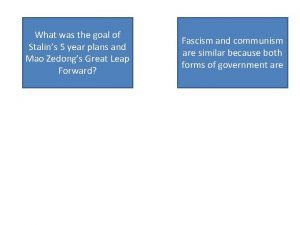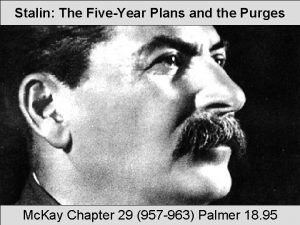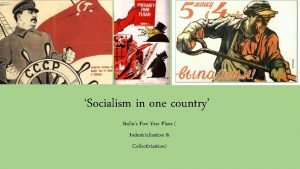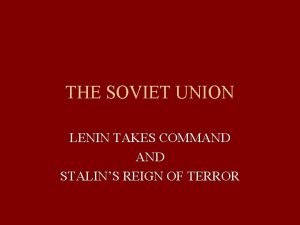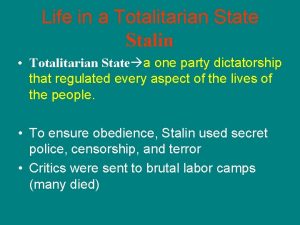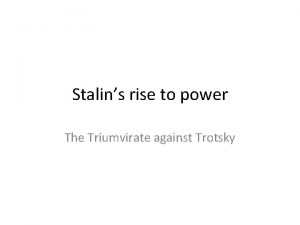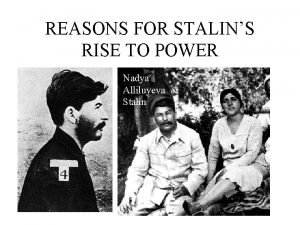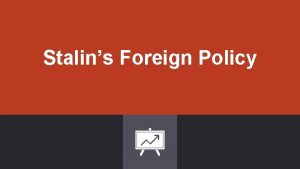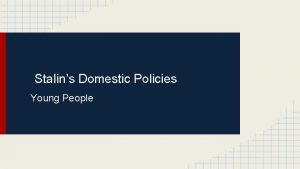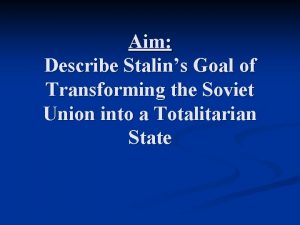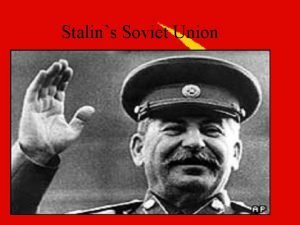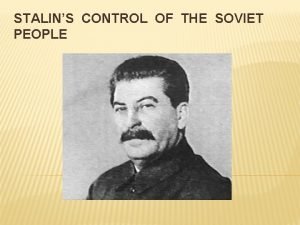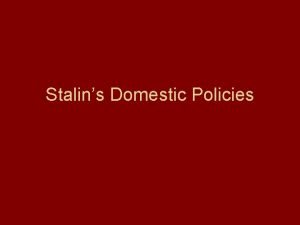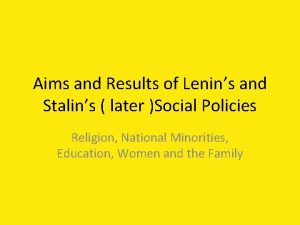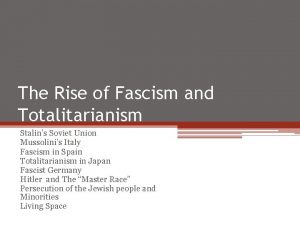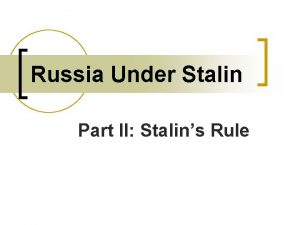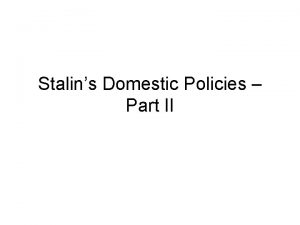What was the goal of Stalins 5 year



























- Slides: 27

What was the goal of Stalin’s 5 year plans and Increase Mao Production Zedong’s Great Leap Forward? Fascism and communism are similar because both forms. Totalitarian of government are

Justice and Human Rights

Justice Fair, equal, and appropriate treatment given to individuals in interpersonal, societal or government interactions. Law codes are ways for civilizations to maintain order.

Hammurabi’s law code Hammurabi’s Code was carved into a pillar in Babylon, a civilization of the Mesopotamian River Valley. It was the first written law code and allow all the people to see the laws. Known as a ruthless law code because of “eye for an eye” Why is it important to have law codes published and available for public viewing?

Rock Pillar Edicts The ancient Buddhist ruler Ashoka helped spread laws using the Pillar Edicts. Ashoka had the rules carved into rock pillars and included code of conduct for all citizens of the Mauryan Empire. The edicts stressed social order, but also promoted religious toleration and acceptance.

Roman 12 Tables Ancient Rome has contributed greatly to today’s world and even to our nation. The law code of Rome, the Twelve Tables is still the basis of our law code today. It included basis for the United States Law code’s 5 principals: 1) 2) 3) 4) 5) People of the same status are equal Innocent until proven guilty Allowed to face accuser and defend oneself Guilt must be clear Judges should base laws on fairness

Justinian Code After the Roman Empire split into East and West Rome, the Eastern half became the Byzantine Empire. The greatest ruler was Justinian who unified the Byzantine Empire and created the Justinian Law Code. This code maintained the principles of the Roman empire and ancient Greek legal principles. We still use the same principles in America’s Legal system.

Limiting Government Despite some great law codes in the Mediterranean Empires, the Northern European Kings were absolute monarchs, often gaining power under Divine Rule. As time passed and the rulers gained more power, the people began to demand change.

Magna Carta The first document to limit a king’s power. It was signed by the King of England in 1215. This document guaranteed a trial and certain rights, but only to the upper classes. The peasants were still vulnerable to the whims of the kings.

English Bill of Rights The Bill of Rights limited the power of the monarchy and gave rights back to the English Citizens The Magna Carta was the first document to take power away from English Monarchs (1215) All Bills of Rights take power from the government and give it to the citizens

Enlightenment Prior to the Enlightenment, kings and monarchs had nearly all the power. Even though there were some minor limits from the Magna Carta and English Bill of Rights, the kings were Divine Rulers. During the Enlightenment thinkers such as John Locke and Montesquieu used inquiry and reason to theorize systems of government that would protect the people. The Enlightenment led to a number of political Revolutions including the French, American and Latin American Revolutions.

Belief System Codes Each belief system has its own code of conduct to ensure good behavior and keep order in society. Belief System Code Christianity 10 Commandments Judaism 10 Commandments Islam 5 Pillars and Sharia Buddhism 4 -noble truths and 8 -fold path Hinduism Caste System (karma and Dharma) Confucianism 5 Relationships Taoism Ying and Yang

Sharia “The Way” Islamic Law based on the fundamental values in the Quran. The Sharia is for religious and secular laws Positives of Sharia: Ban alcohol, drugs, lewd behavior and adultery Negatives of Sharia: Oppress women by limiting their rights, access to education, work and movement. Violent enforcing of the laws. Punishments for violating Sharia are often severe and can include stoning, hanging and shooting executions.

Human Rights Basic political, social and economic rights for all human beings. Since the Enlightenment people have been concerned with their basic human rights. Originally, John Locke claimed that all humans are born with the rights to Life, Liberty and Property. Since WWII much of the world’s nations work together to help secure human rights.

South Africa- Apartheid During Imperialism the British gained control over South Africa and instituted a racial segregation system known as apartheid. This system kept the “colored” and “white” groups separate. Nelson Mandela and a number of other groups kept fighting but it wasn’t until 1994 that Apartheid was finally ended.

British Control- India The British held control over India and called it their Brightest Jewel. The British used the Indians to grow a number of Cash Crops including Cotton and Poppy for Opium. Additionally, the British forced cultural changes on the Indian including outlawing Sati, the Caste System and even ignoring religious values of the Sepoy soldiers. Eventually Gandhi helped the Indians gain independence through nonviolent means.

Tiananmen Square 1989 **People’s Republic of China since 1948 under Mao Zedong** Chinese students gathered in a peaceful protest to gain political freedoms. The Communist Chinese government cracked down and sent in tanks, killing and wounding hundreds Today the People’s Republic of China is still politically totalitarian, but capitalist reforms in the economy have increased China’s economy (Capitalism brought by Deng Xiaoping)

China’s Human Rights Issues -The Great Firewall -One Child Policy -Laogai Camps -Organ Trade -Tibet

Genocides A genocide is the deliberate (intentional) attempt to kill off a certain ethnic or cultural group. There have been many genocides throughout history and have caused the deaths of millions of people.

Irish Potato Famine When a blight killed much of the Irish potato crop, spreading famine and death, the British refused to help. Instead, they continued to demand their “rents” in the form of food crops. Those crops could have fed the Irish, but instead were sent to the British, who already had enough. Ultimately over 1 million Irish died and many more became refugees in Europe, Canada and America

New World Not often viewed as a genocide, the movement of people from the Eastern hemisphere to the Western caused the deaths of millions of people within only a few years from Small Pox. On a greater scale, Columbus’ discovery of the new world also led to the deaths and enslavement of millions of Africans and Native Americans.

Armenia The Armenian genocide occurred in Turkey 1915, right before WWI broke out. Nationalism and conflict was tearing apart the Ottoman empire, and the majority Muslims were looking for who was to blame. They focused on the Christians. False accusations were thrown that the Armenian Christians were helping Russia break down the Empire, because Russia was also Christian. Over 1. 5 Million were killed in just a few short weeks.

Holocaust After losing WWI and taking all the blame, Germany was looking for someone to blame. Under Hitler the Jews became the perfect scapegoat. Hitler began a systematic “Final Solution” to get rid of the “undesirables”. Even before the killing camps, Jews were separated out of the general population, forced to wear special markings and live in overcrowded ghettos. Over 7 million ‘undesirables’ were killed, 6 million were Jews.

Sudan Darfur Many African tribes that have long lasting conflict were put into colonies by the Europeans Imperialism. While the Europeans remained in Africa they tribes couldn’t fight. Once Imperialism ended in 1945, many former colonies experienced brutal genocides due to tribal conflict. In Sudan, Muslim Sudanese attacked and killed Christian boys. Many boys fled for their lives, travelling hundreds of miles to live in refugee camps.

Pol Pot in Cambodia Pol Pot led the Khmer Rouge, a communist group, and took over Cambodia and began a Reign of Terror to get rid of Western influence. Year Zero-- Pol Pot forced Cambodians to move to the country where they worked on farms to grow food More than a million Cambodians were murdered in the “killing fields”, many intellects, politicians and foreigners were targeted. In 1979 Vietnamese troops invaded and kicked Pol Pot out. The Cambodians still struggle to rebuild after losing 1/4 of the population

Killing Fields

Thematic Bullets Theme: Human Rights Throughout history, there have been many examples where groups of people have been denied their human rights. Individuals, groups, and governments have attempted to end many of these human rights violations although they have not always been successful. Task: Select TWO different examples from history where human rights have been denied to groups of people and for EACH -explain the historical circumstances that led to the denial of human rights -describe how the human rights of that group were denied -discuss an action taken by an individual, group, or government that attempted to end the human rights violations
 What was the goal of stalins 5 year plan
What was the goal of stalins 5 year plan Stalins 5 year plan
Stalins 5 year plan Stalin 5 year plan
Stalin 5 year plan Stalins five year plans
Stalins five year plans Stalin becomes dictator date
Stalin becomes dictator date Stalins reign
Stalins reign Stalins totalitarian state
Stalins totalitarian state Bourbon triumvirate background
Bourbon triumvirate background Nadia alliluyeva
Nadia alliluyeva End of year 6 poem
End of year 6 poem Tư thế worm breton là gì
Tư thế worm breton là gì Tư thế ngồi viết
Tư thế ngồi viết ưu thế lai là gì
ưu thế lai là gì Gấu đi như thế nào
Gấu đi như thế nào Thẻ vin
Thẻ vin Thơ thất ngôn tứ tuyệt đường luật
Thơ thất ngôn tứ tuyệt đường luật Các châu lục và đại dương trên thế giới
Các châu lục và đại dương trên thế giới Từ ngữ thể hiện lòng nhân hậu
Từ ngữ thể hiện lòng nhân hậu Diễn thế sinh thái là
Diễn thế sinh thái là V cc cc
V cc cc Làm thế nào để 102-1=99
Làm thế nào để 102-1=99 Chúa yêu trần thế alleluia
Chúa yêu trần thế alleluia Hươu thường đẻ mỗi lứa mấy con
Hươu thường đẻ mỗi lứa mấy con Lời thề hippocrates
Lời thề hippocrates đại từ thay thế
đại từ thay thế Quá trình desamine hóa có thể tạo ra
Quá trình desamine hóa có thể tạo ra Vẽ hình chiếu vuông góc của vật thể sau
Vẽ hình chiếu vuông góc của vật thể sau
